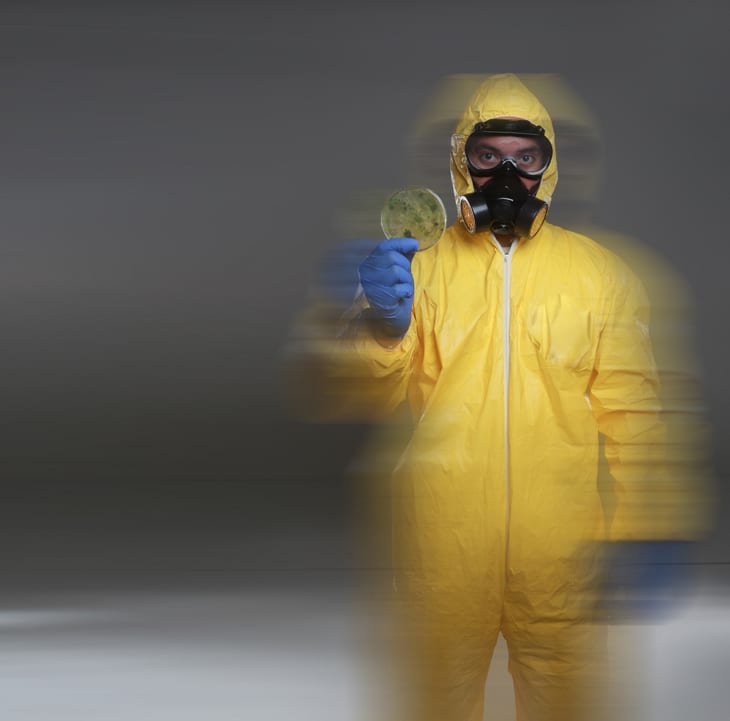
Written by Gearhart and Associates, LLC. for STARC Systems, Inc. Gearhart and Associates are industry experts in Infection Control Risk Assessment (ICRA) training, Infection Control and Prevention Strategies, and Facilities Risk Management.
Bioterrorism, as defined by the Centers for Disease Control and Prevention (CDC), is the intentional release of viruses, bacteria, and/or other germs that can sicken or kill people, livestock, or crops. The agents most likely to be used in a bioterrorist attack are anthrax, plague, botulism, and smallpox which can be spread via contaminated food, water, aerosols, or entry through the skin (NCBI).
Hospital infection strategies are often geared more towards responding to microorganism or endemic pathogens, with bioterrorism lower on the list of concerns. Since the cases of anthrax in the United States (October 4 to November 2, 2001), the need for the development and implementation of preparedness programs has increased to counter deliberately released biological agents.
After the 2001 incident, the US invested heavily in prevention, surveillance, and preparation for potential bioterrorism attacks. In addition, funding was authorized in 2002 to assist the Centers for Disease Control and Prevention, The Department of Health and Human Services (HHS), and The Environmental Protection Agency (EPA) for research and the development of preparedness programs specifically for bioterrorism (NCBI).
Bioterrorism: An Imminent Threat
However, since that time, the level of attention towards the threat of bioterrorism has decreased. In 2017 at the Munich Security Conference, Bill Gates, who uses a vast majority of his wealth to fighting disease through his global foundation, warned global leaders that a genetically engineered virus could kill more people than nuclear weapons, but that no one in the world was prepared for the threat. (The Washington Post)
“I am concerned about biological tools that could be used by a bioterrorist,” Gates said. “Whether it occurs by a quirk of nature or at the hand of a terrorist, epidemiologists say a fast-moving airborne pathogen could kill more than 30 million people in less than a year. And they say there is a reasonable probability the world will experience such an outbreak in the next 10 to 15 years. Governments need to start to prepare for these epidemics the same way they prepare for war.”
He went on to say that the fact that a deadly global pandemic has not occurred in recent history shouldn’t be mistaken for evidence that a deadly pandemic will not occur in the future. (The Guardian)
A bioterrorism event would likely unfold as a disease epidemic, appearing as a natural outbreak. It would not be until after the occurrence that it could be determined if the outbreak was natural or intentional.
Once a biological agent has been detected, treatment of patients and containment of infection is the top priority.
Pandemic Preparedness within Hospital Systems
Dr. Eric Toner, a senior scholar at the John Hopkins Center for Global Health Security, recently designed a simulation that showed what would happen if a new pathogen, a disease-causing agent was released and gave policy experts and governments the opportunity to respond.
The results were dire. The simulation showed 150 million dead around the globe, and over 15 million deaths in the United States just after 20 months.
Dr. Toner response to the outcome was, “It’s because we don’t have the systems we need to enable the kind of response we’d want to see.”
He went on to say that he felt health systems in the United States aren’t ready for an outbreak as the one suggested above. He expressed concern that a pandemic “could cause hospital systems to collapse under the pressure.” (Business Insider)
Healthcare workers are often the first responders in the event of a bioterrorism attack. However, research shows that healthcare staff feels unprepared in responding to a bioterrorist event, with the reasons ranging from not feeling properly trained in handling an incident to not feeling informed of emergency plans (NCBI).
It is up to healthcare leaders to ensure that programs and policies are developed to enable education on bioterrorism, identification, surveillance, the implementation of emergency response plans for pandemic preparedness, proper containment of an outbreak, and the possibility of caring for large numbers of infected casualties.
Planning for Bioterrorism
The STARC temporary containment system allows healthcare staff to be quick and effective during emergency situations, such as a bioterrorism event. The system is designed to be installed easily, relocated quickly, and used incongruent with the facility’s emergency response plan.
Decontamination measures play a huge role in reducing the chance of further contamination during an outbreak. The most common method of decontamination is sealing off the affected area and successfully removing the agent. STARC Systems allows for the containing of high risk contaminated areas to enable aggressive cleaning. STARC System exceeds the ICRA Class IV requirements, the highest risk group assessment classification, is airtight to enable and maintain negative air pressure and has proven to contain airborne particulates and isolate surface contamination.
Further investment in preparedness, awareness, and training can greatly reduce the mortality rate and economic impact in the event of a bioterrorist attack. While the weapon of bioterrorism may not be able to be prevented, STARC Systems can be utilized to control the spread of bioterrorism and play a role in decreasing the impact of bioterrorism events.
Peter Salama, executive director of the World Health Organization, had this to say in regards to the threat of a global pandemic, “It’s not if, but when these events are going to occur again. We need to ramp up our preparedness.”
